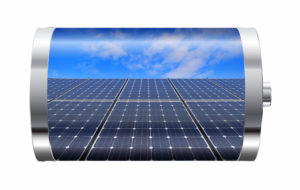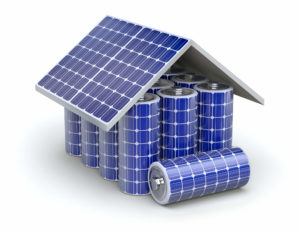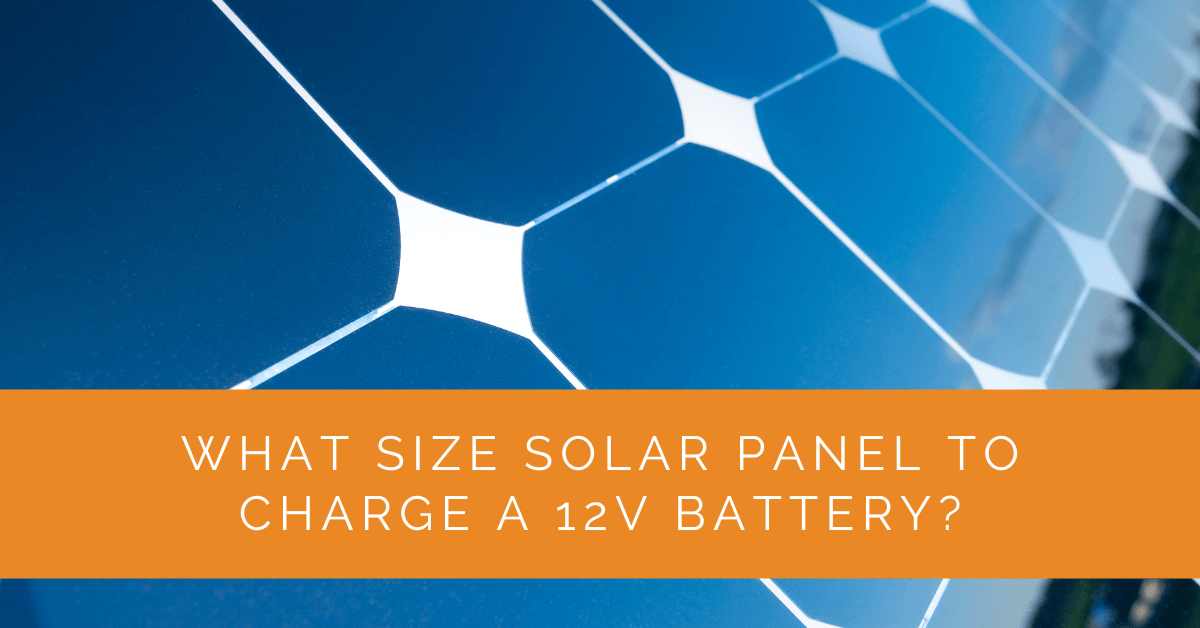As solar energy gains popularity, it is crucial to understand the proper sizing of solar panels for charging 12V batteries. Selecting the right size solar panel is essential for efficient charging and optimal performance. This comprehensive guide will explore different calculation methods and factors that influence the sizing requirements. By the end, you will thoroughly understand what size solar panel is needed to charge your 12V battery effectively.
Contents
- 1 Key Takeaways
- 2 Understanding 12V Batteries
- 3 Calculating Energy Requirements
- 4 Solar Panel Wattage Calculation
- 5 Considerations for Solar Panel Efficiency
- 6 Factors Affecting Solar Panel Sizing
- 7 Sizing Example and Calculation
- 8 Overcoming Limitations and Increasing Efficiency
- 9 Additional Considerations and System Design
- 10 Case Study: Optimizing Solar Panel Size for Efficient 12V Battery Charging
- 11 Expert Insights From Our Solar Panel Installers About What Size Solar Panel to Charge a 12V Battery
- 12 Experience Solar Excellence with Us!
- 13 Conclusion
Key Takeaways
- Before sizing solar panels, grasp the characteristics of 12V batteries, including capacity, voltage, and charge-discharge characteristics.
- Precisely assess the energy needed to charge your 12V battery by considering factors like capacity, desired charging time, and depth of discharge.
- Calculate the solar panel wattage based on factors such as panel efficiency, charging time, and environmental conditions to ensure efficient charging and battery longevity.
Understanding 12V Batteries
Before delving into solar panel sizing, it is important to grasp the characteristics of 12V batteries commonly used in solar power systems. These deep-cycle batteries are designed to provide a steady power flow over an extended period. They are commonly used in off-grid applications and are capable of deep discharges without damaging the battery. Understanding these batteries’ capacity, voltage, and charge-discharge characteristics is crucial for selecting the right solar panel size.
Calculating Energy Requirements
To accurately determine the appropriate solar panel size, it is vital to calculate the energy requirements of your 12V battery. The energy requirements depend on several factors, including the battery capacity, desired charging time, and depth of discharge. Considering these variables, you can precisely assess the energy needed to fully charge your battery and choose a solar panel that meets those requirements.
Solar Panel Wattage Calculation
Once you have determined the energy requirements, you can calculate the wattage of the solar panel needed to charge your 12V battery efficiently. This calculation considers solar panel efficiency, charging time, and environmental conditions. Solar panel efficiency refers to the percentage of sunlight the panel can convert into usable electricity. By selecting a higher-efficiency panel, you can maximize energy harvest and optimize the charging process. Charging time depends on the amount of energy needed, the battery capacity, and the available sunlight. Environmental conditions, such as the amount of sunlight and temperature variations, can also affect the panel’s performance. By accurately sizing your solar panel, you ensure optimal charging and extend the lifespan of your battery.

Considerations for Solar Panel Efficiency
The efficiency of solar panels plays a vital role in the charging process. Higher efficiency panels convert more sunlight into electricity, maximizing the energy available for charging your battery. Solar panel efficiency is affected by several factors, including the quality of the materials, design, and manufacturing processes. It is important to select solar panels with high-efficiency ratings to ensure maximum energy capture.
Factors Affecting Solar Panel Sizing
Several factors influence the sizing of solar panels for charging 12V batteries. Understanding these factors will help you select the ideal solar panel size for your specific needs:
- Battery Capacity: The capacity of your 12V battery determines the amount of energy it can store. A higher-capacity battery will require a larger solar panel to supply the necessary energy for charging.
- Charging Time: The desired charging time also impacts the solar panel size. If you have limited sunlight hours or want to charge your battery quickly, you will need a larger solar panel to generate more energy within a shorter time frame.
- Depth of Discharge: The depth to which you discharge your battery before recharging affects the energy needed for charging. If you frequently discharge your battery deeply, you may need a larger solar panel to compensate for the additional energy required.
- Environmental Conditions: The availability of sunlight in your location and any shading or obstructions that may affect the panel’s exposure to sunlight must be considered. Additionally, temperature variations can impact panel efficiency and overall performance.
You can select the ideal solar panel size that balances energy generation and storage capabilities by carefully evaluating these factors.
Sizing Example and Calculation
To provide a practical understanding of the sizing process, let’s walk through a step-by-step example of calculating the solar panel wattage required to charge a 12V battery.
- Determine Battery Capacity: Start by identifying the capacity of your 12V battery. The capacity is usually measured in amp-hours (Ah) and represents the charge the battery can store. For instance, if your battery has a capacity of 100Ah, it can theoretically provide 1 amp of current for 100 hours.
- Assess Charging Efficiency: Consider the charging efficiency of your system. While it is ideal to have 100% efficiency, various factors, such as wiring losses, charge controller efficiency, and temperature, can impact the overall efficiency. Assume an 80-90% charging efficiency as a rule of thumb.
- Account for Depth of Discharge: Determine your battery’s maximum discharge depth (DoD). The DoD represents the percentage of the battery’s capacity that you intend to use before recharging it. Deep cycle batteries typically have a recommended DoD of 50-80%, meaning you should aim to discharge only up to 50-80% of the battery’s total capacity.
- Calculate Energy Requirement: Multiply the battery capacity (in Ah) by the desired DoD. For example, if your battery has a capacity of 100Ah and you want to discharge it up to 80%, the energy requirement would be 100Ah * 0.8 = 80Ah.
- Determine Charging Energy: To compensate for the charging efficiency, divide the energy requirement by the charging efficiency percentage. For example, if your charging efficiency is 90%, divide the energy requirement 80Ah by 0.9, resulting in 88.9Ah.
- Consider Solar Insolation: Solar insolation measures solar radiation energy received on a given surface area during a specific period. It varies based on geographical location, time of year, and weather conditions. Determine the average daily solar insolation for your region. For example, if your region receives an average of 5 hours of peak sunlight daily, multiply this value by the solar insolation factor to obtain the effective hours of sunlight for charging.
- Calculate Solar Panel Wattage: To calculate the solar panel wattage, divide the charging energy (88.9Ah) by the effective hours of sunlight. For instance, if you have five effective hours of sunlight, the required solar panel wattage would be 88.9Ah / 5h = 17.78A or approximately 178W.
It’s important to note that this is a simplified example, and actual solar panel sizing may require accounting for system losses, temperature coefficients, and future expansion. Consult a solar energy professional for precise sizing specific to your system requirements.

Overcoming Limitations and Increasing Efficiency
To optimize the charging process and increase overall system efficiency, several strategies can be employed:
- Implement a Solar Charge Controller: A solar charge controller acts as a regulator, ensuring that the energy flow from the solar panel to the battery is controlled and efficient. It protects the battery from overcharging and helps optimize the charging process.
- Tilt Angle and Positioning: Adjusting the tilt angle of the solar panel according to your location’s latitude and seasonal changes can optimize the panel’s exposure to sunlight. Proper positioning and avoiding shading from nearby objects will maximize energy capture.
- MPPT Charge Controllers: Maximum Power Point Tracking (MPPT) charge controllers are highly efficient and can extract the maximum available power from the solar panel, especially when there is a temperature variation or shading.
- Expandable Systems: Consider designing your system with expandability in mind. This allows you to add more solar panels in the future if your energy needs increase or if you want to enhance the charging capacity of your battery. Planning for future expansion when designing your solar power system is always a good idea.
- Battery Monitoring: Implement a battery monitoring system to track the state of charge, voltage, and overall health of your 12V battery. This enables you to monitor the charging process and ensure your battery performs optimally.
- System Efficiency and Wiring: Pay attention to system efficiency using appropriately sized wiring and minimizing voltage drop. Efficient wiring reduces energy losses during the transfer of electricity from the solar panel to the battery.
- Proper Maintenance: Regularly clean your solar panels to remove dust, dirt, and debris, as they can reduce the panels’ efficiency. Additionally, inspect the system for any loose connections or faults affecting overall performance.
Additional Considerations and System Design
When designing your solar power system, consider the following factors:
- Battery Type: Different types of batteries, such as lead-acid, lithium-ion, or gel batteries, have varying charging characteristics and requirements. Ensure that the solar panel sizing aligns with the specific requirements of your battery type.
- Use of Charge Controller: Depending on the wattage and characteristics of your solar panel, you may need a charge controller to regulate the charging process. The charge controller prevents overcharging and extends the lifespan of your battery.
- Off-Grid vs. Grid-Tied Systems: Determine whether your solar power system is off-grid or grid-tied. Off-grid systems require larger solar panels to generate enough energy for standalone use. In contrast, grid-tied systems can leverage the grid as a backup power source, reducing the reliance on solar panel size.
- Consultation with Professionals: If you are unsure about the optimal solar panel size or system design for your specific needs, it is advisable to consult with solar energy professionals or experts. They can provide valuable insights, assess your energy requirements, and guide you through selecting the appropriate solar panel size.
Case Study: Optimizing Solar Panel Size for Efficient 12V Battery Charging
Background
At Solar Panels Network USA, we pride ourselves on delivering tailored solar energy solutions that meet our clients’ specific needs. One of our residential clients in a rural area required an off-grid solar power system to charge a 12V battery efficiently. The challenge was to determine the optimal solar panel size that would ensure efficient charging while considering local environmental conditions and the client’s energy usage patterns.
Project Overview
The client needed a reliable solar power system to charge their 12V battery, which powered essential household appliances. The goal was to calculate the appropriate solar panel size that would provide sufficient energy to charge the battery fully, even during periods of limited sunlight.
Implementation
Initial Assessment
We started by assessing the client’s energy requirements and the characteristics of their 12V battery. The battery had a capacity of 100Ah, with a recommended depth of discharge (DoD) of 50-80%. The client needed to ensure the battery was charged daily to maintain a steady power supply.
Calculating Energy Requirements
To determine the energy needed to charge the battery, we considered the following:
- Battery Capacity: 100Ah
- Desired DoD: 80%
- Energy Requirement: 100Ah * 0.8 = 80Ah
Solar Panel Wattage Calculation
Considering the charging efficiency of 90%, we calculated the energy required for charging:
- Charging Energy: 80Ah / 0.9 = 88.9Ah
Next, we factored in the average daily solar insolation for the region, which was approximately 5 hours of peak sunlight:
- Required Solar Panel Wattage: 88.9Ah / 5h = 17.78A or approximately 178W
Selecting the Solar Panel
We recommended a 200W solar panel to ensure sufficient energy generation, accounting for potential system losses and future expansion needs. The higher wattage provided a buffer to accommodate variations in sunlight and seasonal changes.
Considerations for Optimization
Solar Charge Controller
We integrated an MPPT (Maximum Power Point Tracking) charge controller into the system. This type of controller optimizes the power output from the solar panel, especially in varying sunlight conditions, ensuring efficient energy transfer to the battery.
Tilt Angle and Positioning
We adjusted the tilt angle of the solar panel based on the client’s geographical location to maximize sunlight exposure throughout the year. Proper positioning and minimizing shading from nearby objects were also critical to optimizing energy capture.
Battery Monitoring
We installed a battery monitoring system to track the state of charge, voltage, and overall health of the battery. This allowed the client to monitor the charging process and ensure the battery was performing optimally.
Results
By implementing these strategies, the client’s solar power system efficiently charged the 12V battery, providing a reliable power supply for their household needs. The 200W solar panel, combined with the MPPT charge controller and optimal positioning, ensured that the battery was consistently charged, even during periods of limited sunlight.
Summary
This case study demonstrates the importance of accurate solar panel sizing for efficient 12V battery charging. By considering factors such as battery capacity, charging efficiency, and local environmental conditions, Solar Panels Network USA provided a tailored solution that met the client’s energy needs. The integration of advanced technologies, such as MPPT charge controllers and battery monitoring systems, further enhanced the system’s performance and reliability. This approach underscores our commitment to delivering high-quality, sustainable energy solutions that are customized to our clients’ unique requirements.
Expert Insights From Our Solar Panel Installers About What Size Solar Panel to Charge a 12V Battery
Selecting the right size solar panel is essential for efficient charging. By accurately calculating the energy requirements and considering factors like battery capacity and environmental conditions, we ensure that the solar panel provides sufficient power without overloading the system.
Senior Solar Technician
The efficiency of the solar panels is crucial. Higher efficiency panels convert more sunlight into electricity, which is especially important in areas with limited sunlight. This ensures that the battery charges optimally and maintains its longevity.
Lead Installation Specialist
Implementing a solar charge controller can significantly enhance the charging process. It regulates the energy flow, prevents overcharging, and maximizes the efficiency of the system. We always recommend using MPPT charge controllers for the best performance.
Solar Maintenance Expert
Experience Solar Excellence with Us!
Trust in Solar Panels Network USA, where our seasoned experts deliver top-quality solar solutions for homes and businesses nationwide. With a legacy of countless successful installations and a commitment to sustainable energy, we’re your reliable partner in the solar journey. Ready for a brighter, eco-friendly future? Call us now at (855) 427-0058 and harness the power of the sun!
Conclusion
The correct solar panel size is crucial for efficiently charging 12V batteries in solar power systems. By understanding the energy requirements, calculating the appropriate solar panel wattage, considering panel efficiency, and accounting for various factors, you can optimize the performance and effectiveness of your solar power system. With the right-sized solar panel, you can harness the sun’s power to charge your 12V battery effectively and embrace the benefits of renewable and sustainable energy.
Transitioning to solar power provides energy independence and contributes to a greener and more sustainable future. By utilizing solar panels to charge your 12V battery, you reduce your dependence on traditional power sources, lower carbon emissions, and enjoy the advantages of clean, renewable energy. The proper sizing of your solar panel ensures that your battery is charged efficiently, maximizing its lifespan and overall performance.
As you embark on your solar energy journey, consider consulting with solar power professionals or experts to ensure your system is designed and sized correctly. They can provide valuable guidance based on your needs, local conditions, and energy requirements. Embrace the power of solar energy, unlock the potential of your 12V battery charging, and contribute to a more sustainable and eco-friendly world.
About the Author
Solar Panels Network USA stands at the forefront of solar energy solutions, driven by a team of seasoned solar engineers and energy consultants. With over decades of experience in delivering high-quality solar installations and maintenance, we are committed to promoting sustainable energy through customer-centric, tailored solutions. Our articles reflect this commitment, crafted collaboratively by experts to provide accurate, up-to-date insights into solar technology, ensuring our readers are well-informed and empowered in their solar energy decisions.

